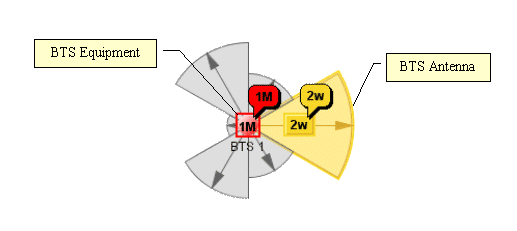Base Transceiver Stations (BTS) are base
stations composed of antennas that relay (receive and transmit)
radio messages within cells of a cellular phone system. Each
antenna has an orientation and a beam width that are graphically
represented. Each antenna can have its own state and graphical
characteristics.
Representing BTS
A BTS object does not have a graphic
representation in the network and equipment components. In these
components, it works as a container that groups a BTS equipment
and BTS antennas.
The following figure shows a BTS object
composed of six BTS antennas.

A BTS representation
The graphic rendering of a BTS antenna
object is optimized for performance using an offscreen buffered
image technique that minimizes the complex shape computations by
pre-rendering the graphic object in memory. The extra memory
required is proportional to the size and number of visible
objects in the network view. To disable the offscreen
optimizations for the BTS antenna representation you should:
- Set the
ilog.tgo.bts.offscreenCachesystem property tofalseat initialization time. - Use the
IltSettings.SetValue("OffscreenCache.BTS", Boolean.FALSE);API call.
For information on how to declare system
properties for Java™ applications and applets, refer to your Java
Runtime documentation.
Customizing the representation of a BTS equipment
A BTS equipment is a network element
object. As such, it follows the same customization as network
elements.
For a complete list of the properties used to customize this kind
of network element, refer to Customizing network element types.
How to change the BTS equipment representation
object."ilog.tgo.model.IltNetworkElement"[type=BTSEquipment] {
btsEquipmentRadius: 15;
}